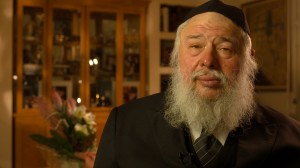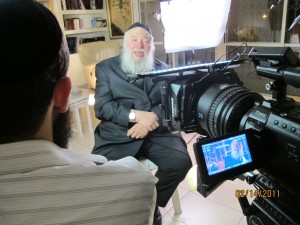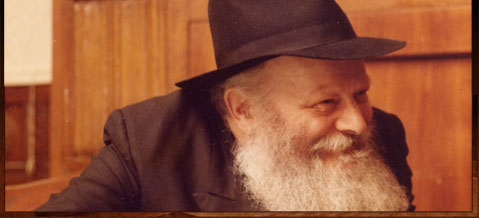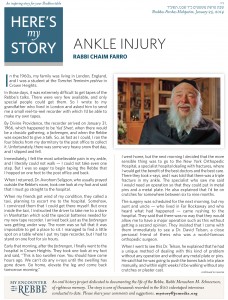HMS: Ankle Injury
22 January 2014
In the 1960s, my family was living in London, England, and I was a student at the Tomchei Temimim yeshiva in Crown Heights.
In those days, it was extremely difficult to get tapes of the Rebbe’s talks. There were very few available, and only special people could get them. So I wrote to my grandfather who lived in London and asked him to send me a small reel-to-reel recorder with which I’d be able to make my own tapes.
By Divine Providence, the recorder arrived on January 31, 1966, which happened to be Yud Shvat, when there would be a chasidic gathering, a farbrengen, and when the Rebbe was expected to give a talk. So, as fast as I could, I ran the four blocks from my dormitory to the post office to collect it. Unfortunately, there was some very heavy snow that day, and I slipped and fell.
Immediately, I felt the most unbelievable pain in my ankle, and I literally could not walk – I could not take even one step. But I was so eager to begin taping the Rebbe that I hopped on one foot to the post office and back.
When I returned, Dr. Avrohom Seligson, who usually prayed outside the Rebbe’s room, took one look at my foot and said that I must go straight to the hospital.When my friends got wind of my condition, they called a taxi, planning to escort me to the hospital.
Somehow, I convinced them that I could get there myself. But once inside the taxi, I instructed the driver to take me to a store in Manhattan which sold the special batteries needed for my new tape recorder. I arrived back just as the farbrengen was getting under way. The room was so full that it was impossible to get a place to sit. I managed to find a little spot on a table where I put my tape recorder, but I had to stand on one foot for six hours.
Early that morning, after the farbrengen, I finally went to the hospital in Crown Heights. They took one look at my foot and said, “This is too swollen now. You should have come hours ago. We can’t do any x-rays until the swelling has gone down. Go home, elevate the leg and come back tomorrow morning.”
I went home, but the next morning I decided that the more sensible thing was to go to the New York Orthopedic Hospital, a specialist hospital dealing with fractures, where I would get the benefit of the best doctors and the best care. There they took x-rays, and I was told that there was a triple fracture in my ankle. The specialist who saw me said I would need an operation so that they could put in metal pins and a metal plate. He also explained that I’d be on crutches for somewhere between six to nine months.
The surgery was scheduled for the next morning, but my aunt and uncle – who lived in Far Rockaway and who heard what had happened – came rushing to the hospital. They said that there was no way that they would allow me to have a major operation such as this without getting a second opinion. They insisted that I come with them immediately to see a Dr. David Telson, a close personal friend of theirs who was a world-famous orthopedic surgeon.
When I went to see this Dr. Telson, he explained that he had a unique method of dealing with this kind of problem without any operation and without any metal plate or pins. He said that he was going to push the bones back into place manually, and within eight weeks I’d be walking without any crutches or plaster cast.
This is what I opted to do, but ten days later my ankle became too painful, and I decided that it would be worthwhile to get a third opinion. So I made an appointment to see another top orthopedic specialist in Manhattan. After he examined my ankle, he said that the doctors at the New York Orthopedic Hospital were quite right. An operation was necessary with everything that entailed – being in a plaster cast for at least six months and having these pins in my foot for the rest of my life.
I wasn’t sure what to do, so I discussed the matter with Rabbi Dovid Raskin, my Rosh Yeshiva, who said, “Write to the Rebbe and ask him what to do.”
I wrote to the Rebbe, and the Rebbe answered, advising me to get the third specialist to speak to Dr. Telson, and whatever they would decide between them, that’s what I should do. And that’s exactly what happened. The two doctors discussed the case, and they agreed that it would do no harm to wait. If there had to be an operation, it could wait a couple of months. By that time we would see whether Dr. Telson’s method was successful or not.
Five weeks after the injury, on Purim, was the famous farbrengen when the Rebbe said that anyone who wanted a blessing from him could come up and ask, and the whole place went absolutely berserk.
But through all the chaos, Rebbe had the clarity of mind to realize that somebody in a far corner of the room, who had a broken ankle and was on crutches, would never reach him amid everyone pressing forward to get a blessing. So the Rebbe called me up in the middle of the farbrengen and gave me wine from his cup. He told me to say L’chaim, and he said that this should be for a full and speedy recovery.
And within six weeks, I was walking on my own two feet without any plaster cast and without any crutches.
A year later I got a letter from the New York Orthopedic Hospital requesting that I allow them to examine my ankle. Apparently, the officials at the hospital had heard about my amazing recovery without any surgery whatsoever and wanted to see for themselves. I went back to Rabbi Raskin, who said, “Without any question, you must go.” So I went.
When I walked into the room, I was in awe: Twelve orthopedic surgeons were sitting around a U-shaped table waiting for me. They put the x-rays of both my ankles up on the screen above their heads, and they said: “Wow!“ They couldn’t believe what they were seeing, because they could hardly make out the difference between the two. They asked me to explain to them what, exactly, had Dr. Telson done, and that gave me the opportunity to tell them about the Rebbe and the special blessings he had given me. Most of them were very obviously Jewish, so it was an opportunity for me to bring credit to the name of Lubavitch and tell these people about the power of the Rebbe’s blessings.
Six months later I was in an audience with the Rebbe, and he asked me about my ankle. So I said, “Baruch Hashem, my ankle is fine.” Then I added: “The only thing is, when it’s rainy and damp, I get a kind of a dull pain in it.” The Rebbe picked up his pencil and scribbled a little note. And from that time on, I’ve felt absolutely no pain whatsoever in my ankle; the pain went away completely.
Rabbi Chaim Farro was sent to Manchester, England as a Chabad Shliach in 1971. He was interviewed in Jerusalem, Israel in February, 2012.
In honor of our dear Rebbe
by Avraham Chaim and Chana Bronstein
In the 1960s, my family was living in London, England, and I was a student at the Tomchei Temimim yeshiva in Crown Heights.
In those days, it was extremely difficult to get tapes of the Rebbe’s talks. There were very few available, and only special people could get them. So I wrote to my grandfather who lived in London and asked him to send me a small reel-to-reel recorder with which I’d be able to make my own tapes.
By Divine Providence, the recorder arrived on January 31, 1966, which happened to be Yud Shvat, when there would be a chasidic gathering, a farbrengen, and when the Rebbe was expected to give a talk. So, as fast as I could, I ran the four blocks from my dormitory to the post office to collect it. Unfortunately, there was some very heavy snow that day, and I slipped and fell.
Immediately, I felt the most unbelievable pain in my ankle, and I literally could not walk – I could not take even one step. But I was so eager to begin taping the Rebbe that I hopped on one foot to the post office and back.
When I returned, Dr. Avrohom Seligson, who usually prayed outside the Rebbe’s room, took one look at my foot and said that I must go straight to the hospital.When my friends got wind of my condition, they called a taxi, planning to escort me to the hospital.
Somehow, I convinced them that I could get there myself. But once inside the taxi, I instructed the driver to take me to a store in Manhattan which sold the special batteries needed for my new tape recorder. I arrived back just as the farbrengen was getting under way. The room was so full that it was impossible to get a place to sit. I managed to find a little spot on a table where I put my tape recorder, but I had to stand on one foot for six hours.
Early that morning, after the farbrengen, I finally went to the hospital in Crown Heights. They took one look at my foot and said, “This is too swollen now. You should have come hours ago. We can’t do any x-rays until the swelling has gone down. Go home, elevate the leg and come back tomorrow morning.”
I went home, but the next morning I decided that the more sensible thing was to go to the New York Orthopedic Hospital, a specialist hospital dealing with fractures, where I would get the benefit of the best doctors and the best care. There they took x-rays, and I was told that there was a triple fracture in my ankle. The specialist who saw me said I would need an operation so that they could put in metal pins and a metal plate. He also explained that I’d be on crutches for somewhere between six to nine months.
The surgery was scheduled for the next morning, but my aunt and uncle – who lived in Far Rockaway and who heard what had happened – came rushing to the hospital. They said that there was no way that they would allow me to have a major operation such as this without getting a second opinion. They insisted that I come with them immediately to see a Dr. David Telson, a close personal friend of theirs who was a world-famous orthopedic surgeon.
When I went to see this Dr. Telson, he explained that he had a unique method of dealing with this kind of problem without any operation and without any metal plate or pins. He said that he was going to push the bones back into place manually, and within eight weeks I’d be walking without any crutches or plaster cast.
This is what I opted to do, but ten days later my ankle became too painful, and I decided that it would be worthwhile to get a third opinion. So I made an appointment to see another top orthopedic specialist in Manhattan. After he examined my ankle, he said that the doctors at the New York Orthopedic Hospital were quite right. An operation was necessary with everything that entailed – being in a plaster cast for at least six months and having these pins in my foot for the rest of my life.
I wasn’t sure what to do, so I discussed the matter with Rabbi Dovid Raskin, my Rosh Yeshiva, who said, “Write to the Rebbe and ask him what to do.”
I wrote to the Rebbe, and the Rebbe answered, advising me to get the third specialist to speak to Dr. Telson, and whatever they would decide between them, that’s what I should do. And that’s exactly what happened. The two doctors discussed the case, and they agreed that it would do no harm to wait. If there had to be an operation, it could wait a couple of months. By that time we would see whether Dr. Telson’s method was successful or not.
Five weeks after the injury, on Purim, was the famous farbrengen when the Rebbe said that anyone who wanted a blessing from him could come up and ask, and the whole place went absolutely berserk.
But through all the chaos, Rebbe had the clarity of mind to realize that somebody in a far corner of the room, who had a broken ankle and was on crutches, would never reach him amid everyone pressing forward to get a blessing. So the Rebbe called me up in the middle of the farbrengen and gave me wine from his cup. He told me to say L’chaim, and he said that this should be for a full and speedy recovery.
And within six weeks, I was walking on my own two feet without any plaster cast and without any crutches.
A year later I got a letter from the New York Orthopedic Hospital requesting that I allow them to examine my ankle. Apparently, the officials at the hospital had heard about my amazing recovery without any surgery whatsoever and wanted to see for themselves. I went back to Rabbi Raskin, who said, “Without any question, you must go.” So I went.
When I walked into the room, I was in awe: Twelve orthopedic surgeons were sitting around a U-shaped table waiting for me. They put the x-rays of both my ankles up on the screen above their heads, and they said: “Wow!“ They couldn’t believe what they were seeing, because they could hardly make out the difference between the two. They asked me to explain to them what, exactly, had Dr. Telson done, and that gave me the opportunity to tell them about the Rebbe and the special blessings he had given me. Most of them were very obviously Jewish, so it was an opportunity for me to bring credit to the name of Lubavitch and tell these people about the power of the Rebbe’s blessings.
Six months later I was in an audience with the Rebbe, and he asked me about my ankle. So I said, “Baruch Hashem, my ankle is fine.” Then I added: “The only thing is, when it’s rainy and damp, I get a kind of a dull pain in it.” The Rebbe picked up his pencil and scribbled a little note. And from that time on, I’ve felt absolutely no pain whatsoever in my ankle; the pain went away completely.
Rabbi Chaim Farro was sent to Manchester, England as a Chabad Shliach in 1971. He was interviewed in Jerusalem, Israel in February, 2012.
In honor of our dear Rebbe
by Avraham Chaim and Chana Bronstein






No Comments to “HMS: Ankle Injury”